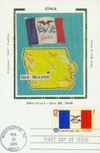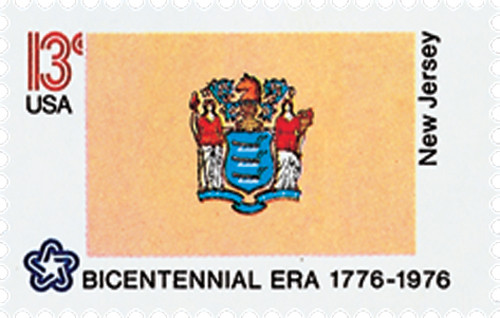
# 1661 - 1976 13c State Flags: Iowa
U.S. 1661
1976 Iowa
State Flags
American Bicentennial Series
• First time a sheet 50 had all different stamp designs
• Part of the American Bicentennial Series
Stamp Category: Commemorative
Series: American Bicentennial Series
Value: 13¢ First-class postage rate
First Day of Issue: February 23, 1976
First Day City(s): Washington, DC
Quantity Issued: 8,720,100 (panes of 50)
Printed by: Bureau of Engraving and Printing
Printing Method: Photogravure
Format: Sheet of 50
Perforations: 11
Why the stamp was issued:
The United States Postal Service celebrated the American Bicentennial with a full pane of the Union’s fifty state flags.
About the stamp design:
During World War II, a troop of Iowans stationed along the Mexican border expressed an interest in carrying a banner to identify their origins. When Governor William L. Harding ordered that a banner be sent to the troops, he quickly discovered that Iowa did not have a flag. With the help of the Society of the Daughters of the American Revolution, Iowa held a design contest in search of a flag design. The winning design, by Mrs. Dixie Gebhardt, was selected on May 11, 1917. Gebhardt’s design featured an eagle on a white stripe between a red stripe (for courage) and a blue stripe (for loyalty, justice, and truth). The state name is written below the eagle in red, to symbolize the sacrifices of the men who went to war.
About the printing process:
Printed by the Bureau of Engraving and Printing on their seven-color Andreotti gravure press (601) which was their work horse for multicolored stamps.
About the American Bicentennial Series:
In the 1970s, America celebrated its 200th anniversary with hundreds of national events commemorating the heroes and historic events that led to our nation’s independence from Great Britain. The U.S. Postal Service issued 113 commemorative stamps over a six-year period in honor of the U.S. bicentennial, beginning with the American Revolution Bicentennial Commission Emblem stamp (U.S. #1432). As a group, the Bicentennial Series chronicles one of our nation’s most important chapters, and remembers the events and patriots who made the U.S. a world model for liberty.
Several of the stamps honored colonial life – craftsmen and communication. Other stamps honored important battles including Lexington and Concord, Bunker Hill, and Saratoga. Significant events such as the Boston Tea Party, the meeting of the First Continental Congress, and the Declaration of Independence were featured as well. The stamps also honored many significant people such as George Washington, Sybil Ludington, Salem Poor, and the Marquis de Lafayette.
Many of the stamps feature classic artwork. For instance, the set of four souvenir sheets picture important events recreated by noted artists such as John Trumbull. The Bicentennial Series also includes an important US postal first – the first 50-stamp se-tenant – featuring all 50 state flags. The format proved to be popular with collectors, and has been repeated many times since.
The American Bicentennial Series is packed with important US history – it tells the story of our nation’s fight for independence through stamps.
History the stamp represents:
On December 28, 1846, Iowa was admitted as our 29th state.
On June 17, 1673, two French explorers, Louis Jolliet and Father Jacques Marquette, became the first white people to arrive in Iowa. They traveled by canoe down the Wisconsin River to the Mississippi River, and landed on the Iowa side on June 25th.
A French-Canadian, Julien Dubuque, received permission from the Fox Indians to mine lead in 1788, near the site of today’s Dubuque. Dubuque was Iowa’s first European settler, and he stayed there until his death in 1810. After Dubuque settled in Iowa, a small number of hunters and trappers also settled there.
In 1812, Iowa became part of the Territory of Missouri when Louisiana became a state. During the early 1800s, fur companies set up trading posts on the Des Moines, Mississippi, and Missouri Rivers. Officially Indian land, Iowa was closed to settlers. When Missouri became a state in 1821, Iowa became part of an unorganized territory.
The U.S. government forced many Sauk and Fox Indians living in Illinois to move to Iowa. One leader, Chief Black Hawk, refused to move. In the Black Hawk War, fought in 1832, U.S. troops defeated Indian forces. After the war, the Indians lost additional territory in Iowa along the Mississippi River. White settlers quickly moved in. In 1834, the region was made part of the Territory of Michigan. Then in 1836, the Territory of Wisconsin was created.
On June 12, 1838, the land west of the Mississippi was separated from the Wisconsin Territory and organized as the Territory of Iowa. This land included all of Iowa, most of Minnesota, and two-thirds of North and South Dakota. Burlington served as the first capital until 1841, when it was moved to Iowa City.
Iowa’s territorial governor proposed statehood as early as 1839. However, Iowans opposed statehood, as that would require a tax to pay the salaries of local officials. In 1844, a constitutional convention was held, but disagreement over the state’s boundaries defeated statehood. In 1846, another convention was held, which adopted the state’s present boundaries.
U.S. 1661
1976 Iowa
State Flags
American Bicentennial Series
• First time a sheet 50 had all different stamp designs
• Part of the American Bicentennial Series
Stamp Category: Commemorative
Series: American Bicentennial Series
Value: 13¢ First-class postage rate
First Day of Issue: February 23, 1976
First Day City(s): Washington, DC
Quantity Issued: 8,720,100 (panes of 50)
Printed by: Bureau of Engraving and Printing
Printing Method: Photogravure
Format: Sheet of 50
Perforations: 11
Why the stamp was issued:
The United States Postal Service celebrated the American Bicentennial with a full pane of the Union’s fifty state flags.
About the stamp design:
During World War II, a troop of Iowans stationed along the Mexican border expressed an interest in carrying a banner to identify their origins. When Governor William L. Harding ordered that a banner be sent to the troops, he quickly discovered that Iowa did not have a flag. With the help of the Society of the Daughters of the American Revolution, Iowa held a design contest in search of a flag design. The winning design, by Mrs. Dixie Gebhardt, was selected on May 11, 1917. Gebhardt’s design featured an eagle on a white stripe between a red stripe (for courage) and a blue stripe (for loyalty, justice, and truth). The state name is written below the eagle in red, to symbolize the sacrifices of the men who went to war.
About the printing process:
Printed by the Bureau of Engraving and Printing on their seven-color Andreotti gravure press (601) which was their work horse for multicolored stamps.
About the American Bicentennial Series:
In the 1970s, America celebrated its 200th anniversary with hundreds of national events commemorating the heroes and historic events that led to our nation’s independence from Great Britain. The U.S. Postal Service issued 113 commemorative stamps over a six-year period in honor of the U.S. bicentennial, beginning with the American Revolution Bicentennial Commission Emblem stamp (U.S. #1432). As a group, the Bicentennial Series chronicles one of our nation’s most important chapters, and remembers the events and patriots who made the U.S. a world model for liberty.
Several of the stamps honored colonial life – craftsmen and communication. Other stamps honored important battles including Lexington and Concord, Bunker Hill, and Saratoga. Significant events such as the Boston Tea Party, the meeting of the First Continental Congress, and the Declaration of Independence were featured as well. The stamps also honored many significant people such as George Washington, Sybil Ludington, Salem Poor, and the Marquis de Lafayette.
Many of the stamps feature classic artwork. For instance, the set of four souvenir sheets picture important events recreated by noted artists such as John Trumbull. The Bicentennial Series also includes an important US postal first – the first 50-stamp se-tenant – featuring all 50 state flags. The format proved to be popular with collectors, and has been repeated many times since.
The American Bicentennial Series is packed with important US history – it tells the story of our nation’s fight for independence through stamps.
History the stamp represents:
On December 28, 1846, Iowa was admitted as our 29th state.
On June 17, 1673, two French explorers, Louis Jolliet and Father Jacques Marquette, became the first white people to arrive in Iowa. They traveled by canoe down the Wisconsin River to the Mississippi River, and landed on the Iowa side on June 25th.
A French-Canadian, Julien Dubuque, received permission from the Fox Indians to mine lead in 1788, near the site of today’s Dubuque. Dubuque was Iowa’s first European settler, and he stayed there until his death in 1810. After Dubuque settled in Iowa, a small number of hunters and trappers also settled there.
In 1812, Iowa became part of the Territory of Missouri when Louisiana became a state. During the early 1800s, fur companies set up trading posts on the Des Moines, Mississippi, and Missouri Rivers. Officially Indian land, Iowa was closed to settlers. When Missouri became a state in 1821, Iowa became part of an unorganized territory.
The U.S. government forced many Sauk and Fox Indians living in Illinois to move to Iowa. One leader, Chief Black Hawk, refused to move. In the Black Hawk War, fought in 1832, U.S. troops defeated Indian forces. After the war, the Indians lost additional territory in Iowa along the Mississippi River. White settlers quickly moved in. In 1834, the region was made part of the Territory of Michigan. Then in 1836, the Territory of Wisconsin was created.
On June 12, 1838, the land west of the Mississippi was separated from the Wisconsin Territory and organized as the Territory of Iowa. This land included all of Iowa, most of Minnesota, and two-thirds of North and South Dakota. Burlington served as the first capital until 1841, when it was moved to Iowa City.
Iowa’s territorial governor proposed statehood as early as 1839. However, Iowans opposed statehood, as that would require a tax to pay the salaries of local officials. In 1844, a constitutional convention was held, but disagreement over the state’s boundaries defeated statehood. In 1846, another convention was held, which adopted the state’s present boundaries.


















